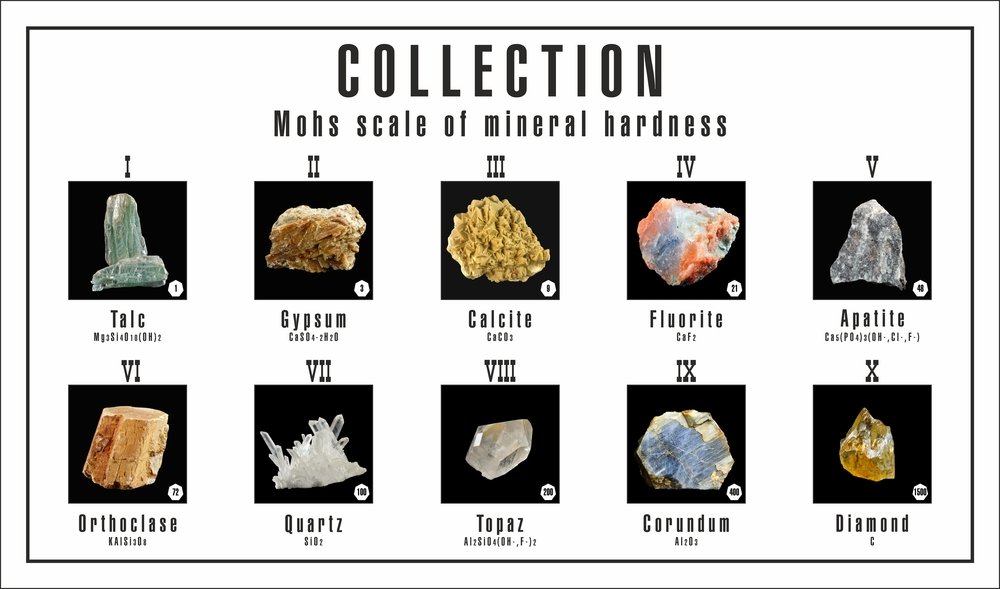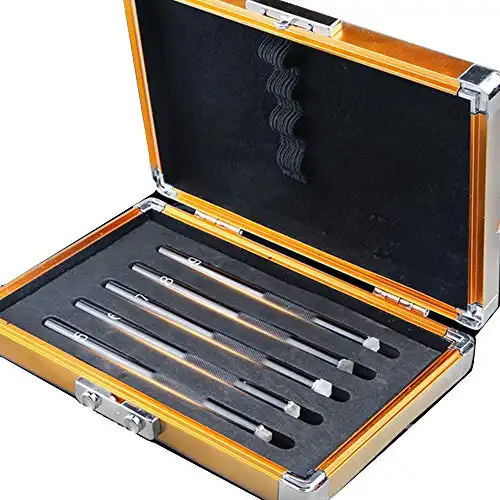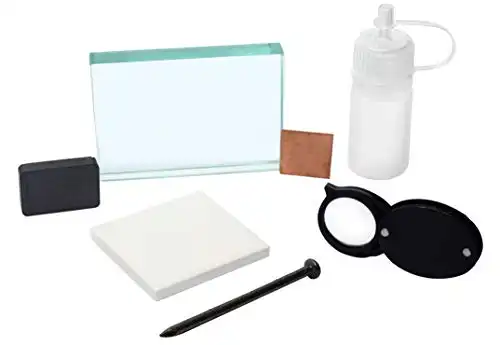The Moh’s Hardness Scale
If you’re going to collect, or work, with minerals then you should know a bit about the Moh’s scale. It’s one of the best ways to start identifying minerals, and it has a surprising amount of application in other areas.
So, let’s hop into it and I’ll teach you more than you ever thought you needed to know in our guide to the Moh’s scale of hardness.
Moh’s Hardness Scale Cheat Sheet
Just need some quick examples for comparison?
The following chart will give you some common examples at each stop along the way from talc to diamond, and how some everyday objects fit in.
| Hardness Level | Sample Mineral | Non-Mineral (comparison) |
|---|---|---|
| 1 | Talc | |
| 2 | Gypsum | Fingernail |
| 3 | Calcite | Copper/Silver |
| 4 | Flourite | |
| 5 | Apatite | Regular Knife Blade |
| 6 | Feldspar | Glass |
| 7 | Quartz | Hardened Steel |
| 8 | Topaz | |
| 9 | Corundum | Tungsten Carbide |
| 10 | Diamond |
Here’s another visual representation of the same minerals listed in the above scale of hardness.

That should give you a good idea of how to test the hardness of most minerals, at least if you have some other samples and some of the things on the right.
But there’s far more to the Moh’s scale of hardness than the commonly seen charted minerals.
What is the Moh’s Scale of Hardness?
The Moh’s scale is the system we use to determine how hard a mineral is. Hardness is a key factor in mineral identification, and it also affects the way we approach working with stones as lapidaries.
The scale was invented by Friedrich Mohs, a famous german geologist. He covered it in his 1822
Basically, some people figured out that minerals scratch each other depending on hardness. Diamond scratching quartz is a good example. Good old Friedrich Mohs just decided to codify things by using known materials and having access to a wider range of minerals than the ancients.
The Moh’s scale is actually one of the least precise ways to measure material hardness but it remains common for minerals. It’s very useful for field identification of the various minerals but the Moh’s scale is a qualitative ordinal scale.
Sound complicated?
It’s not, statisticians just like to use hyper-specific terms for datasets.
What it actually means is that Moh’s scale of hardness is self-referential and the data organizes itself into distinct categories.
What it’s not is a measured hardness on a quantitative scale. The differences between hardness levels vary, but it seems that stones are pretty easy to classify this way. They tend to fall into a few distinct categories. Well, ten distinct categories.
So, the Moh’s scale can tell you my custom steel knife is harder than something like serpentine, but it won’t make a scratch on corundum. What it can’t tell you is an exact hardness for the knife, since there’s no exact about the Moh’s scale for the most part.
This can drive newbies with an affinity for math insane. If you want exact data that can be compared outside of the system, you need to look into the Vicker’s Scale of Hardness, which is much more exact.
But every rockhound should know how minerals and other materials interact with each other.
Defining a Scratch
Before we get into the practical aspects of using the Moh’s scale, we need to talk about how a scratch is defined.
Specifically, it refers to non-elastic surface deformation that is visible to the naked eye.
In other words, the scratch has to be a permanent one and it should be visible for it to be considered in rough hardness testing.
Of note, however, is that you should always run a finger over the scratch. I’ve had cases where I thought I had a scratch from my knife, only to later find out the material was harder than anticipated and it had instead removed a small amount of steel from the knife and deposited it on the stone in question.
So how do we use this practically?
Field Identification Using the Moh’s Scale
The most popular amateur use of the Moh’s scale is in field identification. If you’re out rockhounding and have questions about something you’ve found, you’ll find out that there are few other quick and reliable tests.
For instance, if I’m searching for jasper in the local riverbed I know that it’s around a 6 in hardness. It looks similar to some of the serpentine in the area as well, but the difference is my knife will leave a deep gouge in serpentine but only scratch jasper with extreme effort.
I recommend keeping the following in your bag when out in the field:
- A good knife
- A rock pick
- A piece of glass
- A bit of copper wire or a penny
The glass can be anything, but something thick with rounded corners is best for obvious reasons. Especially if you tend to be rough on your pack.
Knives are very variable, my pocket knife for daily carry is around a 5 on the Moh’s, while the field knife I carry while hounding is about a 6..
Glass has a similar hardness, but you usually scratch minerals on the glass instead of trying to scratch them with the glass. I usually have a jar in my bag for other reasons, but it’s always handy if I’m trying to figure something out.
Basic procedures will vary depending on your targeted stone.
For instance, if I’m looking for agate I’ll do the following when I’ve found a suspected nodule:
- Break off dirt and any loose matrix. It doesn’t matter if I scratch the limestone, I need to get to the harder stuff. I’ll use my pick to remove it if necessary.
- Scratch test it with my knife. If it scratches easily I don’t have an agate. If it scratches with great effort, I may have an agate that’s on the soft side.
- Attempt to scratch the jar with the agate. If it scratches very easily, I’ve got about a 90% chance of it being an agate. If it scratches only with a serious effort it’s probably another form of cryptocrystalline quartz.
The problem with using field identification in this manner is twofold.
The main problem for most people is that they don’t plan their field testing ahead. I do most of my hunting along a 20 mile stretch of a creek bed and I know the place well. I know which stones are down there, how hard they are, and where to dig.
If you’re in an unknown area it complicates things a bit since you can run into unknown minerals.
It’s also only a rough approximation. The Moh’s scale is self-referential and prone to human error.
That said, some basic tools and understanding how the Moh’s scale work is one of the most powerful tools at your disposal for field identification of specimens.
Using Moh’s Hardness Kits
There are a few varieties of kit out there to help identify minerals.
Full confession: I’ve only used an actual kit once while collecting specimens with a friend going for his degree in geology. The kit I used was a “pick” kit, which has a bunch of little tools that have a different hardness on the tips.
That said, not every unknown specimen is found in the field. These kits can be used for a wide variety of purposes at home, but most people will use them to take a look at specimens they bought or otherwise came to them with no identification.
Pick kits are a professional tool, but they’re rather expensive. More common among amateurs are simple identification kits which do a great job for those who don’t just have the materials lying around.
Kits are great for newbies since they’ll have a known hardness with no testing. You may want to pick one up if you’re still feeling antsy about picking out your own bits of hardness testing tools.
Moh’s Hardness Scale For Selected Minerals and Gemstones
| Diamond | 10 | Hypersthene | 5 – 6 |
| Synth. Moissanit | 9½ | Ilmenite | 5 – 6 |
| Ruby | 9 | Lapis Lazuli | 5 – 6 |
| Sapphire | 9 | Lazulite | 5 – 6 |
| Alexandrite | 8½ | Nepheline | 5 – 6 |
| Chrysoberyll | 8½ | Neptunite | 5 – 6 |
| Holtite | 8½ | Pargasite | 5 – 6 |
| YAG | 8½ | Richterite | 5 – 6 |
| Zirconia | 8½ | Samarskite | 5 – 6 |
| Rhodizite | 8 – 8½ | Stibiotantalite | 5 – 6 |
| Taafeite | 8 – 8½ | Tremolite | 5 – 6 |
| Spinel | 8 | Turquoise | 5 – 6 |
| Topaz | 8 | Analcime | 5 – 5½ |
| Aquamarine | 7½ – 8 | Datolite | 5 – 5½ |
| Red Beryl | 7½ – 8 | Durangite | 5 – 5½ |
| Precious Beryl | 7½ – 8 | Eudialyte | 5 – 5½ |
| Gahnite | 7½ – 8 | Goethite | 5 – 5½ |
| Galaxite | 7½ – 8 | Herderite | 5 – 5½ |
| Painite | 7½ – 8 | Hydroxylherderite | 5 – 5½ |
| Phenakite | 7½ – 8 | Meliphanite | 5 – 5½ |
| Emerald | 7½ – 8 | Mesolite | 5 – 5½ |
| Andalusite | 7½ | Microlite | 5 – 5½ |
| Euclase | 7½ | Monazite | 5 – 5½ |
| Hambergite | 7½ | Natrolite | 5 – 5½ |
| Sapphirine | 7½ | Nickeline | 5 – 5½ |
| Dumortierite | 7 – 8½ | Papagoite | 5 – 5½ |
| Almandine | 7 – 7½ | Psilomelane | 5 – 5½ |
| Boracite | 7 – 7½ | Scolecite | 5 – 5½ |
| Cordierite | 7 – 7½ | Sellaite | 5 – 5½ |
| Danburite | 7 – 7½ | Thomsonite | 5 – 5½ |
| Grandidierite | 7 – 7½ | Titanite | 5 – 5½ |
| Pyrope | 7 – 7½ | Wolframite | 5 – 5½ |
| Schorlomite | 7 – 7½ | Yttrotantalite | 5 – 5½ |
| Sekaninaite | 7 – 7½ | Apatite | 5 |
| Simpsonite | 7 – 7½ | Bismutotantalite | 5 |
| Spessartine | 7 – 7½ | Childrenite | 5 |
| Staurolite | 7 – 7½ | Chlorapatite | 5 |
| Turmaline | 7 – 7½ | Dioptase | 5 |
| Uvarovite | 7 – 7½ | Eosphorite | 5 |
| Amethyst | 7 | Flourapatite | 5 |
| Aventurine | 7 | Hemimorphite | 5 |
| Rock Crystal | 7 | Hydroxylapatite | 5 |
| Chambersite | 7 | Mangan-Apatite | 5 |
| Chromdravite | 7 | Odontolite | 5 |
| Citrine | 7 | Rinkite | 5 |
| Forsterite | 7 | Schlossmacherite | 5 |
| Povondraite | 7 | Smithsonite | 5 |
| Quartz | 7 | Spurrite | 5 |
| Smoky Quartz | 7 | Strass | 5 |
| Zunyite | 7 | Vayrynenite | 5 |
| Garnet | 6½ – 7½ | Ekanite | 4½ – 6½ |
| Jeremejevite | 6½ – 7½ | Apophyllite | 4½ – 5 |
| Sillimanite | 6½ – 7½ | Augelite | 4½ – 5 |
| Zircon | 6½ – 7½ | Charoite | 4½ – 5 |
| Axinite | 6½ – 7 | Gaspéite | 4½ – 5 |
| Chalcedony | 6½ – 7 | Hodgkinsonite | 4½ – 5 |
| Chrysoprase | 6½ – 7 | Legrandite | 4½ – 5 |
| Diaspore | 6½ – 7 | Pectolite | 4½ – 5 |
| Ferro-Axinite | 6½ – 7 | Scheelite | 4½ – 5 |
| Gadolinite | 6½ – 7 | Wardite | 4½ – 5 |
| Grossular | 6½ – 7 | Wollastonite | 4½ – 5 |
| Hiddenite | 6½ – 7 | Bayldonite | 4½ |
| Jadeite | 6½ – 7 | Colemanite | 4½ |
| Jasper | 6½ – 7 | Parisite | 4½ |
| Kornerupine | 6½ – 7 | Prosopite | 4½ |
| Kunzite | 6½ – 7 | Yugawaralite | 4½ |
| Mangan-Axinite | 6½ – 7 | Kyanite | 4 – 7 |
| Peridot | 6½ – 7 | Sérandite | 4 – 5½ |
| Pollucite | 6½ – 7 | Chabazite | 4 – 5 |
| Serendibite | 6½ – 7 | Friedelite | 4 – 5 |
| Sinhalite | 6½ – 7 | Lithiophilite | 4 – 5 |
| Spodumene | 6½ – 7 | Mordenite | 4 – 5 |
| Tanzanite | 6½ – 7 | Triphylite | 4 – 5 |
| Thorianite | 6½ – 7 | Variscite | 4 – 5 |
| Tinzenite | 6½ – 7 | Zincite | 4 – 5 |
| GGG | 6½ | Carletonite | 4 – 4½ |
| Magnesio-Axinite | 6½ | Hübnerite | 4 – 4½ |
| Nambulite | 6½ | Purpurite | 4 – 4½ |
| Vesuvianite | 6½ | Algodonite | 4 |
| Cassiterite | 6 – 7 | Ammonite | 4 |
| Clinozoisite | 6 – 7 | Barytocalcite | 4 |
| Epidote | 6 – 7 | Flourite | 4 |
| Hancockite | 6 – 7 | Leucophanite | 4 |
| Pyrolusite | 6 – 7 | Libethenite | 4 |
| Sogdianite | 6 – 7 | Rhodochrosite | 4 |
| Amazonite | 6 – 6½ | Magnesite | 3½ – 4½ |
| Andesine | 6 – 6½ | Siderite | 3½ – 4½ |
| Anorthoclase | 6 – 6½ | Ankerite | 3½ – 4 |
| Benitoite | 6 – 6½ | Aragonite | 3½ – 4 |
| Bixbyite | 6 – 6½ | Azurite | 3½ – 4 |
| Bytownite | 6 – 6½ | Chalcopyrite | 3½ – 4 |
| Chondroite | 6 – 6½ | Creedite | 3½ – 4 |
| Helvite | 6 – 6½ | Cuprite | 3½ – 4 |
| Hyalophane | 6 – 6½ | Dickinsonite | 3½ – 4 |
| Labradorite | 6 – 6½ | Dolomite | 3½ – 4 |
| Marcasite | 6 – 6½ | Euchroite | 3½ – 4 |
| Microcline | 6 – 6½ | Langbeinite | 3½ – 4 |
| Nephrite | 6 – 6½ | Malachite | 3½ – 4 |
| Norbergite | 6 – 6½ | Mimetite | 3½ – 4 |
| Oligoclase | 6 – 6½ | Pentlandite | 3½ – 4 |
| Petalite | 6 – 6½ | Powellite | 3½ – 4 |
| Prehnite | 6 – 6½ | Scorodite | 3½ – 4 |
| Pyrite | 6 – 6½ | Shungite | 3½ – 4 |
| Rutile | 6 – 6½ | Shattuckite | 3½ – 4 |
| Sanidine | 6 – 6½ | Sphalerite | 3½ – 4 |
| Smaragdite | 6 – 6½ | Wavellite | 3½ – 4 |
| Sugilite | 6 – 6½ | Wurtzite | 3½ – 4 |
| Tantalite | 6 – 6½ | Adamite | 3½ |
| Xonotlite | 6 – 6½ | Anhydrite | 3½ |
| Zoisite | 6 – 6½ | Chiolite | 3½ |
| Aegirine | 6 | Huréaulite | 3½ |
| Amblygonite | 6 | Strontianite | 3½ |
| Clinohumite | 6 | Thaumasite | 3½ |
| Humite | 6 | Weloganite | 3½ |
| Hurlbutite | 6 | Cacoxenite | 3 -4 |
| Lawsonite | 6 | Coral | 3 -4 |
| Pumpellyite | 6 | Ludlamite | 3 -4 |
| Tephroite | 6 | Anglesite | 3 – 3½ |
| Vlasovite | 6 | Baryte | 3 – 3½ |
| Zektzerite | 6 | Boleite | 3 – 3½ |
| Hematite | 5½ – 6½ | Cerussite | 3 – 3½ |
| Hedenbergite | 5½ – 6½ | Celestine | 3 – 3½ |
| Magnetite | 5½ – 6½ | Descloizite | 3 – 3½ |
| Manganotantalite | 5½ – 6½ | Greenockite | 3 – 3½ |
| Opal | 5½ – 6½ | Howlite | 3 – 3½ |
| Rhodonite | 5½ – 6½ | Millerite | 3 – 3½ |
| Actinolite | 5½ – 6 | Phosphophyllite | 3 – 3½ |
| Allanite | 5½ – 6 | Witherite | 3 – 3½ |
| Anatase | 5½ – 6 | Bornite | 3 |
| Beryllonite | 5½ – 6 | Calcite | 3 |
| Brookite | 5½ – 6 | Kurnakovite | 3 |
| Bustamite | 5½ – 6 | Shortite | 3 |
| Canasite | 5½ – 6 | Wulfenite | 3 |
| Cobaltite | 5½ – 6 | Serpentine | 2½ – 5½ |
| Euxenite | 5½ – 6 | Pearl | 2½ – 4½ |
| Fabulite | 5½ – 6 | Jet | 2½ – 4 |
| Fergusonite | 5½ – 6 | Chalcocite | 2½ – 3 |
| Haüyne | 5½ – 6 | Crocoite | 2½ – 3 |
| Leucite | 5½ – 6 | Gaylussite | 2½ – 3 |
| Marialite | 5½ – 6 | Gold | 2½ – 3 |
| Meionite | 5½ – 6 | Inderite | 2½ – 3 |
| Milarite | 5½ – 6 | Lepidolite | 2½ – 3 |
| Montebrasite | 5½ – 6 | Pyrargyrite | 2½ – 3 |
| Natromontebrasite | 5½ – 6 | Silver | 2½ – 3 |
| Periclase | 5½ – 6 | Stolzite | 2½ – 3 |
| Pyroxmangite | 5½ – 6 | Vanadinite | 2½ – 3 |
| Sarcolite | 5½ – 6 | Whewellite | 2½ – 3 |
| Scorzalite | 5½ – 6 | Brucite | 2½ |
| Scapolite | 5½ – 6 | Cryolite | 2½ |
| Sodalite | 5½ – 6 | Linarite | 2½ |
| Tugtupite | 5½ – 6 | Lizardite | 2½ |
| Brazilianite | 5½ | Proustite | 2½ |
| Breithauptite | 5½ | Sturmanite | 2½ |
| Chromite | 5½ | Chrysocolla | 2 – 4 |
| Enstatite | 5½ | Clinochrysotile | 2 -3 |
| Linobate | 5½ | Fuchsite | 2 -3 |
| Magnesiochromite | 5½ | Muscovite | 2 -3 |
| Moldavite | 5½ | Phosgenite | 2 -3 |
| Willemite | 5½ | Shomiokite | 2 -3 |
| Aeschynite | 5 – 6 | Amber | 2 – 2½ |
| Bronzite | 5 – 6 | Cinnabar | 2 – 2½ |
| Cancrinite | 5 – 6 | Ettringite | 2 – 2½ |
| Catapleiite | 5 – 6 | Kämmererite | 2 – 2½ |
| Ceruléite | 5 – 6 | Mellite | 2 – 2½ |
| Clinoenstatite | 5 – 6 | Senarmontite | 2 – 2½ |
| Davidite | 5 – 6 | Ulexite | 2 – 2½ |
| Diopside | 5 – 6 | Villiaumite | 2 – 2½ |
| Ferrosilite | 5 – 6 | Gypsum | 2 |
| Hornblende | 5 – 6 | Stichtite | 1½ – 2½ |
| Sulphur | 1½ – 2½ | ||
| Covellite | 1½ – 2 | ||
| Melonite | 1½ – 2 | ||
| Realgar | 1½ – 2 | ||
| Vivianite | 1½ – 2 | ||
| Palygorskite | 1 – 2 | ||
| Pyrophyllite | 1 – 2 | ||
| Talc | 1 |
- Online rock and mineral club for collectors of all levels!
- Find community with like-minded rock and mineral enthusiasts.
- Monthly Giveaways!
- Free Access to Entire Digital Library of Products (current and future products)*




